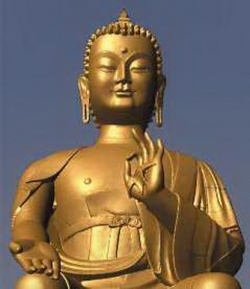Emptiness / Buddhanature
by Traleg Kyabgon Rinpoche
The Buddhist schools are rich and varied in their perspectives, but these many points of view all advance the Buddhist concept of the middle view (madhya-drshti in Sanskrit and ume tawa in Tibetan).
The middle view avoids the extremes of eternalism and nihilism. Any view that does not fall into the parameters of the middle view—in other words, all views that fall into the extremes of eternalism or nihilism—are referred to as wrong views in Buddhist literature. The Buddha and his subsequent followers have called these wrong views because the nihilistic view minimizes what is there in reality, while the eternalistic view adds more to reality than what is really there.
Adherents of all Buddhist schools try to understand everything about themselves—their consciousness, the material world, sentient life, their karmic inheritance and its history, even rebirth or reincarnation—in terms of this middle view. In the Mahayana tradition, the establishment of the middle way is also an aspect of one’s own practice, because the Buddhist adherent steers a course between the two extremes to cultivate the two wisdoms: transcendental knowledge (Skt., prajna) and wisdom/gnosis (Skt., jnana).
The Madhyamaka and Yogacara Schools
With the emergence of Mahayana thought, this middle view was critically examined and taken to highly refined levels of philosophical sophistication. There were two major strands of Buddhist thought in the Mahayana: Madhyamaka and Yogacara. These two schools have had an enormous impact on the cultural, philosophical and religious landscape of Buddhist thinking in the whole of Asia, from India to Japan and beyond. Madhyamaka and Yogacara have produced original and somewhat different (although not necessarily incompatible) interpretations of the middle view. Their perspective on how enlightenment is to be attained is also different.
For the Madhyamikas (or Shunyatavadins), enlightenment is obtained by the practice of the two accumulations, merit and wisdom. In order to carry out this necessary but difficult task with minimal risk of deviations and diversions, the practitioner must engage in the six transcendental actions (Skt., paramitas). From the first four transcendental actions one accumulates merit, while the last two transcendental actions lead to the accumulation of wisdom (which includes both transcendental knowledge and wisdom/gnosis). The reason for practicing these accumulations is to reduce one’s negative karmic inheritance and delusional tendencies. As Nagarjuna, the founder of the Madhyamaka school, continually stated, it is only by developing the middle view that one can gain an understanding of emptiness (Skt., shunyata), which is ultimate reality itself. This understanding of emptiness is applied to the rest of the transcendental actions, so that even the merit that issues forth from one’s practice is seen to be empty of substance or inherent existence. In other words, it is through the realization of emptiness that one attains enlightenment.
The Yogacarins (or Vijnanavadins), on the other hand, advanced a slightly different perspective on how the two accumulations are to be realized. For Maitreya and Asanga, the founders of the Yogacara school, the main concern was establishing buddhanature (Skt., tathagatagarbha) as fact.
It was their firm belief that the reality of buddhanature was the foundation upon which all the Mahayana paths and stages were to be erected. They reasoned that if enlightenment were possible—not just in principle but as a realizable actuality—then each sentient creature must possess that enlightened nature. It is only due to the presence of ignorance that sentient creatures have not realized their “existentially intimate” and yet “experientially and cognitively distant” nature.
The key text that Maitreya and Asanga authored—which is widely used by followers of the Kagyü and Nyingma traditions of Tibetan Buddhism—is known as the Mahayanuttaratantra (in one of its shorter names). Its recurrent theme is the removability of the defilements. These defilements are all that obscure the innate purity of one’s inherent buddhanature, which exists in an uncorrupted and incorruptible fashion within the continuum of one’s being.
The difference between these two philosophical schools is that the Madhyamikas see the realization of emptiness as the one uniquely significant insight, whereas the Yogacarins see the realization of buddhanature as the very essence of awakening. In the Prajnaparamita sutras, the canonical Mahayana Buddhist sutras upon which Nagarjuna singularly relied, the subject matter is principally about emptiness. In them, shunyata is portrayed as the “Mother of all the buddhas,” because enlightenment arises from the realization of emptiness. According to the Yogacarins, the source of enlightenment is buddhanature, which is pure and untainted by defilements. However, it is the understanding of emptiness that allows one to realize this buddhanature.
There is very little evidence in Indian literature to suggest that there were any critical exchanges in India between these two prominent Buddhist philosophical schools. However, after the transplantation of Buddhism to Tibet, matters became wildly different. Rival schools of Tibetan Buddhist tradition, each claiming to be faithfully following the preceding Indian schools, engaged in a flurry of scholarly exchanges in which the concept of buddhanature was subjected to severe critical discussion.
These rival schools could not agree on the nature of buddhadharma and its status within the Mahayana teachings as a whole. Their disputes mainly came down to this: “Is buddhanature to be treated as a definitive teaching, or is it an interpretative teaching that relies on explanations to reveal itself?” Many latter-day Kagyü masters, for example, came to accept the teachings on buddhanature as belonging to the definitive class of Mahayana teachings. Those who followed strictly Madhyamaka interpretations of emptiness, on the other hand, did not accept this interpretation. For them, it had pedagogical value only, something that an individual grows out of as he or she develops a deeper understanding of emptiness. They argued that it is only through emptiness that all conceptual categories are deconstructed, and that these conceptual categories include the notion of buddhanature.
We can see, then, that the Yogacara teachings have had just as much influence on the development of Kagyü and Nyingma thought as the Madhyamaka ones, although no Kagyü or Nyingma teacher would consider him- or herself to be a Yogacarin. What the early and contemporary Kagyü teachers have done is combine the Yogacara teachings on buddhanature and the Madhyamaka teachings on emptiness.
The Rangtong and Shentong Distinction
Further complications regarding the understanding of buddhanature occurred in Tibet as a result of the marriage of these two streams of thought within the Kagyü and other Buddhist schools. This marriage led to the development of the distinctly Tibetan philosophical tradition called the Shentong (“emptiness of other”) school. The Shentongpas charged those schools that interpreted the teachings on emptiness as definitive with falling into the extreme of nihilism. These schools, known in this context as upholders of Rangtong (“emptiness of itself”), counter-charged the Shentongpas with falling into the extreme of eternalism.
It should be noted at this point that many great Kagyü and Nyingma masters have not arrived at the same conclusion as the Shentongpas regarding the concept of buddhanature. Rather, they have accepted the reality of buddhanature while maintaining the Rangtong view of emptiness of itself. Accepting the reality of buddhanature does not mean that one has to accept the Shentong interpretation of emptiness. Shentongpas regard the nature of mind as empty of defilements but not empty of its intrinsic nature. The notion of buddhanature, however, does not in itself imply that mind has any intrinsic nature. Many of the great Kagyü and Nyingma masters, in fact, have interpreted buddhanature to mean that mind is empty of both the defilements and any kind of inherent existence.
The Mahayanuttaratantra itself may yield a conclusion that is consistent with the Rangtong view of emptiness of itself. A true Shentongpa, if there is such a person, is seen by Rangtongpas as always being at risk of reifying buddhanature, thus falling into the extreme of eternalism—a Buddhist heresy. However, for our purposes, we need not be detained by these different interpretations. Suffice it to say that the appropriations and intermingling of the Madhyamaka and Yogacara traditions within Tibetan Buddhism has had a rather complicated and illustrious history. This is not the place to assess and evaluate the legitimacy of the claims and counter-claims, let alone defend this or that master’s favored interpretation. Rather, I would like to offer a general outline of buddhanature, with certain inspirations drawn from the teachings of the mainstream Kagyü tradition.
Teachings on Buddhanature
The Kagyüpas rely on the Mahayanuttaratantra as the main text on buddhanature. According to the Uttaratantra (its shorthand name) we all possess buddhanature. Our true nature is said to be untainted and not devalued by defilements, delusions, obscurations and other pollutants. However, buddhanature is obscured by those defilements, which have their origins in primordial ignorance. As such, these defilements and obscurations have to be removed. Their removal will lead to the realization of buddhanature, and the realization of buddhanature is equated with the attainment of true freedom or liberation.
Thus, freedom and determinism are not incompatible in the Buddhist philosophical tradition. In fact, according to the Buddhist teachings, freedom is contingent on understanding the prevailing and predetermined karmic causes and conditions in our lives. An act of freedom is not regarded as something that occurs in a miraculous fashion, as if our actions had no antecedent causal conditions. Only by understanding the governing causes and conditions—which have led to our present state of bondage in samsara—can we entertain the possibility of achieving true freedom. If we are to have any real chance of realizing ultimate freedom, we need to understand how such and such causes and conditions have contributed to our state of bondage, and we need to understand the factors that sustain the underlying mechanisms of samsaric imprisonment. According to the teachings on buddhanature, our state of ignorance and the obscurations that govern our current state of being are caused by distorted thoughts, conflicting emotions and unbridled instinctual feelings. However, because these things are a product of causes and conditions, they can be illuminated and renounced. Their potential removability, combined with the primordial presence of buddhanature, is what makes liberation possible. In the Uttaratantra, the following three reasons are given for this possibility of liberation:
The defilements are removable.
Owing to ignorance, we have unconsciously become afflicted by distorted thoughts, corrupted by conflicting emotions, and led astray by erroneous views and misunderstandings. These various states and tendencies of the mind supply the necessary materials for the formation of fairly stable and persistent character traits, personality structures, self-images and habit patterns. However, although these deluded states of mind—the source of all of one’s misery and anguish—are persistent, they are not permanent fixtures of one’s dispositional properties. Therefore, they are removable and can be jettisoned, provided one engages in the appropriate methods of training.
The remedial qualities and attributes that tend towards enlightenment are already present.
We have the ability to accomplish the difficult, although not impossible, task of eradicating undesirable, self-destructive and degrading states and habits of mind. This is due fundamentally to the wholesome states of the mind and traits that one can cultivate and develop by and within oneself. Therefore, we do not need to draw on divine inspiration in the form of grace. It is evident that liberation is attained through personal effort and not through the bestowal of salvation by an ultimate Other.
Buddhanature is not different from the nature of a fully enlightened being.
Our true nature is buddhanature and that buddhanature is the nature of all sentient beings. Therefore, it is not our nature that separates sentient beings such as ourselves from the fully enlightened beings—although there certainly is a temporal gap that separates the time before and the time after the onset of enlightenment. Since our true nature is the nature of the buddhas, the temporal divide that separates these two states can be narrowed for now and completely bridged in the future.
The Conditioned Nature of Mind
Heeding the authoritative nature of the Mahayanuttaratantra and other such texts, followers of Mahayana are counselled to become what they were portended to become in the first place. In a manner of speaking, buddhanature is the very purpose of one’s life, the destiny that one is almost necessarily propelled towards—the very raison d’être of one’s existence. The Uttaratantra, in fact, suggests that our sense of incompleteness and meaninglessness, our feelings of emptiness, dissatisfaction and disquiet, our experience of unhappiness and the litany of other samsaric misfortunes we have, are all indicators of the stirrings of buddhanature that we must heed and respond to.
Furthermore, the Uttaratantra elaborates upon the reasons why, as human beings, we fail to achieve our potential, to actualize our true nature. This temporary failing on our part—which is all that it is according to the Uttaratantra—is attributable to the conditioned nature of our minds. Although our own nature is buddhanature, our thoughts and actions spring not from this unconditioned state but from the deluded and conditioned nature of our minds. As such, every physical, verbal and mental act we perform leaves imprints on our body-mind complex.
It is worth pointing out that in Buddhism, mind does not refer to what we normally mean by consciousness, where consciousness is narrowly defined as that which is opposite to the material or corporeal, and thus of a totally different nature. In Buddhism, mind encompasses the working of any organism that has input/output functions and responds to stimuli. In other words, what is mental is the same as what is sentient. (The term sentient covers a broad range of living organisms, from the microscopic organisms of aquatic life to highly intelligent, fully realized human beings.) Nothing that sentient beings experience—either on the conscious sentient level or the unconscious level—vanishes. The resulting imprints influence, mold, shape and color the subsequent experiences of the individual.
The Mahayana teachings mention four different imprints, known as traces and dispositions:
Perceptual traces and dispositions: This means that if we perceive something through our sensory apparatuses, those experiences leave imprints on our brain/mind structure. If we perceive a visual object, even after we stop seeing it in our visual field, that object will continue to appear to our consciousness. For example, an item of clothing in a shop window that caught our eye will subsequently appear to the mind as a mental image. Similarly with audial perceptions, if we hear music that we enjoy, we will continue to hear that tune played over and over in our mind. Of course, these sensory experiences are not simply mentally registered; we respond to them in various ways because of our likes, dislikes, attractions, aversions and so on, thus inculcating ever more fixed predilections and propensities.
Traces and dispositions of apperception: This means that every experience we have is processed, organized and edited, as it were, by the self, although the subject may not be conscious of this process at the time. In other words, there is a self-referential element attached to most of our experiences, so that the experiences that we have through the self are given certain unique characteristics. In this way, they become dispositional properties of the self.
Traces and dispositions of conditioned existence: According to Buddhism, particularly Mahayana Buddhism, there are no physical or mental substances. There are only interacting, mutually interconnected networks of states and processes, brought about by causes and conditions. The causes and conditions themselves are not based in any kind of metaphysical ground. They simply constitute a network of interacting states and processes. The mind, with its conceptual categories and schemas, creates our dispositional properties—in conjunction with the neurochemical activities of the brain, other psychophysical states and processes, and external sensory stimuli.
Traces and dispositions of homogeneity: This last category simply means that our imprints will reflect our current state of mind, as will the future experiences these imprints bring about. For example, if one has the experience of anger, the imprint of anger will give rise to future experiences of anger. A similar process will operate with regard to the wholesome states.
The Four Renunciations
We can see, then, that to realize our buddhanature we have to deal with causes and conditions and work with our states of mind with ever-increasing vigilance, mindfulness and awareness. We have to become aware of what sort of likes and dislikes we have, what sort of thoughts we entertain most of the time, what kind of emotional conflicts we habitually perpetuate, and the manner in which we habitually respond to various circumstances, situations and events in life. Knowing more about our potential, on the one hand, and the states and propensities that prevent us from realizing that true potential, on the other, is what leads to the attainment of true freedom or enlightenment.
In order to realize our true potential, we have to engage in what are known as the four renunciations. One engages in these practices to attenuate the forces of habit, so that there will be a marked decrease in the unwholesome, non-virtuous, dispositional properties and a corresponding increase in the wholesome and virtuous dispositional properties.
The first two renunciations consist of thinking about one’s unwholesome states of mind, dispositional properties and habit patterns. Having done so, one should make a pledge to oneself, appealing to one’s own more noble nature by saying, “Whatever unwholesome states of mind, dispositions and propensities that have not yet arisen, I will do everything to make sure that they will not arise in the future.” By engaging in pre-emptive measures, such as the cultivation of mindfulness and awareness, one should also do whatever one can to reduce those unwholesome, non-virtuous states that have already arisen and in so doing attenuate their force.
The second two renunciations consist of the positive side. One must ensure that all of the wholesome states of mind and the virtuous dispositional states and habit patterns that have not yet arisen will arise in the future. One must also vow to do everything within one’s power to increase and inculcate those virtuous and wholesome dispositional properties and habit patterns that have already arisen. By the cultivation of virtues and wholesome qualities and the renunciation of vices and unwholesome qualities, one realizes buddhanature and thus attains buddhahood.
Traleg Kyabgon Rinpoche is a lama in the Kagyü tradition of Tibetan Buddhism. He lives in Melbourne, Australia, where he founded the E-vam Institute. He also recently established the E-vam Institute in Hudson, New York.







